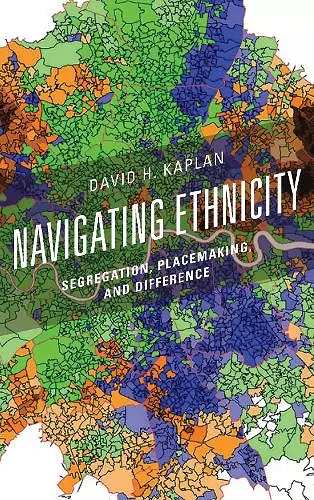Navigating Ethnicity
Segregation, Placemaking, and Difference
Format:Paperback
Publisher:Rowman & Littlefield
Published:3rd Aug '17
Currently unavailable, and unfortunately no date known when it will be back
This paperback is available in another edition too:
- Hardback£78.00(9781538101889)

This important book provides a novel perspective on ethnicity, nationality, and race by considering how they are shaped by their geography. Exploring the complicated terrain of ethnicity through an expansive global perspective, David H. Kaplan traces the spatial arrangements that convey such potent meaning to the identity and opportunities of members of any cultural group. With examples from around the world, the author considers the most important aspects of ethnicity—from segregation to place making to multiculturalism, culture regions, diasporas, and transnationalism. He frames ethnicity as a contingent phenomenon, showing how context and place determine the position, definitions, behaviors, and attitudes toward and by members of an ethnic group. Drawing on an impressive depth of historical and empirical detail, Kaplan’s analysis of the critical role of ethnicity in everyday geographies makes a major contribution to the field.
Geography professor Kaplan (Kent State Univ.) seeks to extend understanding of ethnicity through the heretofore largely ignored lens of geography and space. He begins by tracing the evolution of the conceptualization of ethnicity, noting seminal contributions from sociology, anthropology, psychology, history, and political science, among other disciplines. However, he is particularly interested in examining “how ethnicity plays out on the ground.” Kaplan comprehensively explores spatial boundaries between groups, taking into account geographical context and its intersection with such factors as class, gender, and age. He also addresses motives for (and causes of) ethnic segregation, be it externally driven from intergroup exploitation and conflict, or internally rooted in voluntary seclusion. Acknowledging the segregation that exists, the author presents comprehensive research on both the negative and positive consequences of ethnic concentration, leaving it to readers to ultimately decide if such segregation is functional or dysfunctional for society. Finally, Kaplan envisions the future of ethnicity, taking into account the latent consequences of contemporary social forces including transnationalism, urbanization, and globalization. Overall, a well-researched and unique contribution in the ever-salient field of ethnicity and ethnic relations. Summing Up: Highly recommended. Graduate students/faculty/professionals. * CHOICE *
David Kaplan has put together a rich, well-organized manuscript. Having published extensively in the areas of urban and social/cultural geography, he brings in-depth knowledge to the challenges facing immigrants as well as their ethnic imprint on our increasingly culturally diverse cities. This manuscript fills major gaps in the literature and adds another layer of understanding to the deep but complex forces (demographic, social, cultural, economic, and political) shaping global multicultural cities. Not only does Kaplan achieve his primary objectives and clearly answer his research questions but he does so in a remarkable way, delivering an innovative, well-organized book of interest to academics and non-academics alike. The chapters are full of useful information and are highly readable. I hope that Kaplan’s timely, well-written book will encourage further comparative research on ethnic groups around the world. * Journal of Urban Affairs *
Centering around the discussions of ethnicity and its spatial manifestation in different parts of the world, David Kaplan’s cogent book offers a comprehensive geographical overview across space and over time. Its contextualization of ethnic identity encompasses the tremendous complexity of contemporary urban ethnicity. It is an excellent addition to the existing literature as both a textbook and a scholarly reference. -- Wei Li, University of Arizona
Navigating Ethnicity is a thought-provoking and important contribution that tackles the extremely complicated terrain of ethnicity using a global perspective. The author does an exemplary job exploring the “frustrating richness” of ethnicity (p. 18). Worthy of note is that the author promises to do this “across the world” (p. 19), and, indeed, he does bring up dozens of examples of how ethnicity is manifested in multiple and different contexts. This is the most valuable element of the book, as the reader learns how the concept of ethnicity shifts across borders and between and within places. The overall conclusion from reviewers is that the book is excellent in explaining key concepts and providing informative examples of how ethnicity plays a role in everyday geographies. * AAG Review of Books *
Offering a superbly researched tour de force on ethnic groups around the world, David Kaplan addresses the major topics of this subject in clear language that gives access to students without talking down to advanced readers. He addresses advantaged and disadvantaged ethnic communities, modes of immigrant insertion, ethnic business, neighborhood formation, common measurement methods, clustered and dispersed groups, diasporas, hybrids, and transnationals, pulling it all together with illustrations from around the globe. The book will be widely read and find a place on the bookshelf of every scholar who takes an interest in this topic. -- Ivan Light, University of California, Los Angeles
Centering around the discussions of ethnicity and its spatial manifestation in different parts of the world, David Kaplan’s cogent book offers a comprehensive geographical overview across space and over time. Its contextualization of ethnic identity encompasses the tremendous complexity of contemporary urban ethnicity. It is an excellent addition to the existing literature as both a textbook and a scholarly reference. -- Wei Li, University of Arizona
Navigating Ethnicity is a monumental achievement that explores the origins of ethnicity in its many forms around the globe. Using both historical and contemporary examples, David Kaplan makes a compelling case that ethnicity and multiculturalism are shaped by geography—from nation-states to cities to neighborhoods. He systematically illustrates how ethnicity and geography are inextricably linked in ways that create and reinforce social boundaries and status hierarchies among peoples. -- Daniel T. Lichter, Cornell University
ISBN: 9781538101896
Dimensions: 229mm x 151mm x 19mm
Weight: 399g
258 pages